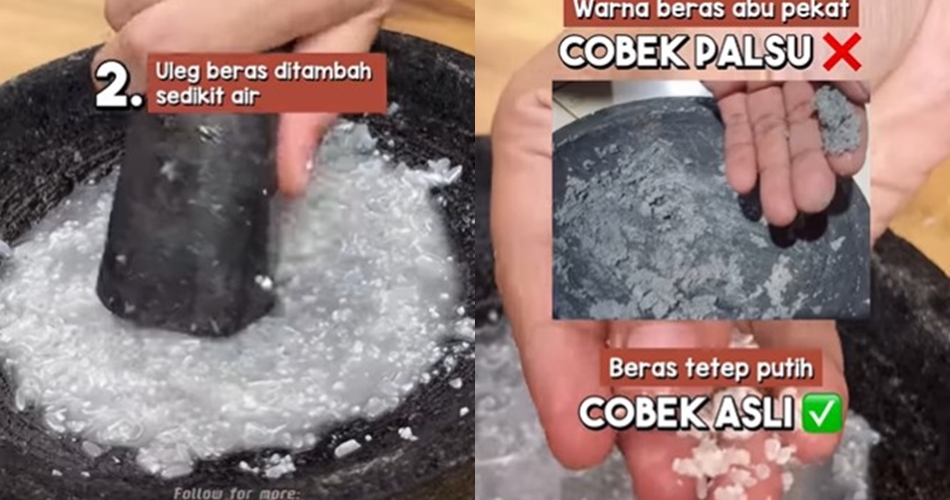foto: Instagram/@tempatku.pulang
Brilio.net - Cobek is a traditional kitchen tool that still exists today. In fact, a number of people admit that using a mortar and mortar to grind food can make the taste and texture better than using a blender or chopper. There are many types of mortars, but stone mortars are the most popular because they are strong and durable.
However, sometimes many stone mortar traders are not honest when trading by selling fake mortars. So, instead of being made from real stone, there are rogue traders who make them from cement. In fact, cement contains certain substances that are dangerous if mixed with food and enter the body.
This was experienced by netizens on the Instagram account @placku.pulang. He admitted that he had used a fake mortar for several years because he didn't know the difference. After searching for information from various sources, he finally discovered the risks of using a cement mortar, namely that it could cause cancer because cement contains silica and abscesses which are carcinogenic.
"I actually don't understand this, but when I checked it for fun, I was really shocked, especially since this mortar has been with me for 2 years," he wrote in an Instagram upload @placeku.pulang, quoted by BrilioFood on Thursday (14/3).
To find out the difference between real and fake stone mortars, people usually use the technique of grinding salt into the mortar. However, netizens on the Instagram account @placku.pulang have another method that is no less effective, and it only uses one kitchen ingredient that everyone definitely has at home.
How to distinguish between real and fake stone mortars.
The first thing that must be prepared is a basin filled with water. After that, soak the mortar and mortar you want to check into it. Then, leave it for 30 minutes. After leaving it for 30 minutes, the real and fake stone mortars showed different reactions, you know.
If it's a genuine mortar, after soaking it for a long time, there won't be any changes to the soaking water. This is different from the fake stone mortar which shows the appearance of water bubbles after being soaked.

photo: Instagram/@whereku.pulang
Next, if you are still not really sure whether your mortar is made of real or fake stone, you can do another technique. To do this, sprinkle the mortar with enough rice, then add a little water. Grind the rice until the texture is quite smooth.
If the rice you grind remains white without changing color, it means the mortar you are using is made from real stone. On the other hand, if the rice changes color to gray or black, that means your mortar is made of cement.

photo: Instagram/@whereku.pulang
So, from now on you don't need to worry about using the wrong mortar anymore because you already know how to differentiate between real and fake stone mortars, right?
Taking a peek at the Instagram upload @placku.pulang which has been watched 9 million times, quite a few netizens feel helped by this tutorial, you know. On the other hand, there are also those who share other methods.
"What material is the original mortar made of?" asked Instagram @fairyteeth, then the video owner replied, "from natural stone, sis."
"The easiest way to test a fake mortar is to douse it with HCl acid solution (porstex, vixal, wpc,) or HSO (battery water). If the mortar is fake because it is made of cement, the cement will definitely dissolve and the sand will fall out," said Instagram @aldipm_mobil_bekas_segar.
"Actually, you can see from the texture, that real stone tends to be porous and the color is the same on all sides, if there are spots with contrasting colors you can suspect that it is cement or other materials. If you are passing through the Magelang area, you can stop by the stone craftsmen around Muntilan, guaranteed "original because it was made using Merapi stone," wrote Instagram @magelang.
View this post on Instagram
How to clean a stone mortar after use.
Cleaning a stone mortar so that it is clean can be done in a few simple steps. Following are the steps.
1. Soak in mild soapy water.
First, soak a stone mortar in warm water with a little mild soap. Leave it for a few minutes to soften the stuck-on dirt.
2. Scrub with a soft brush.
After soaking, use a toothbrush or other soft brush to gently scrub the surface of the stone mortar. Make sure to clean all the nooks and crannies.
3. Rinse with clean water.
After scrubbing, rinse the stone mortar with clean water to remove soap residue and dirt.
4. Use baking soda.
If there are still stains or an unpleasant odor, you can mix a little baking soda with water to make a paste. Apply this paste to the surface of the stone mortar and leave it for a few minutes before rinsing again with clean water.
5. Dry with a clean cloth.
After washing, dry the stone mortar using a clean, dry cloth. Make sure to dry the entire surface so that no water remains.
6. Important things to remember when cleaning the mortar.
Avoid using harsh chemicals or rough tools such as steel brushes, as these can damage the surface of the stone mortar.
(brl/tin)